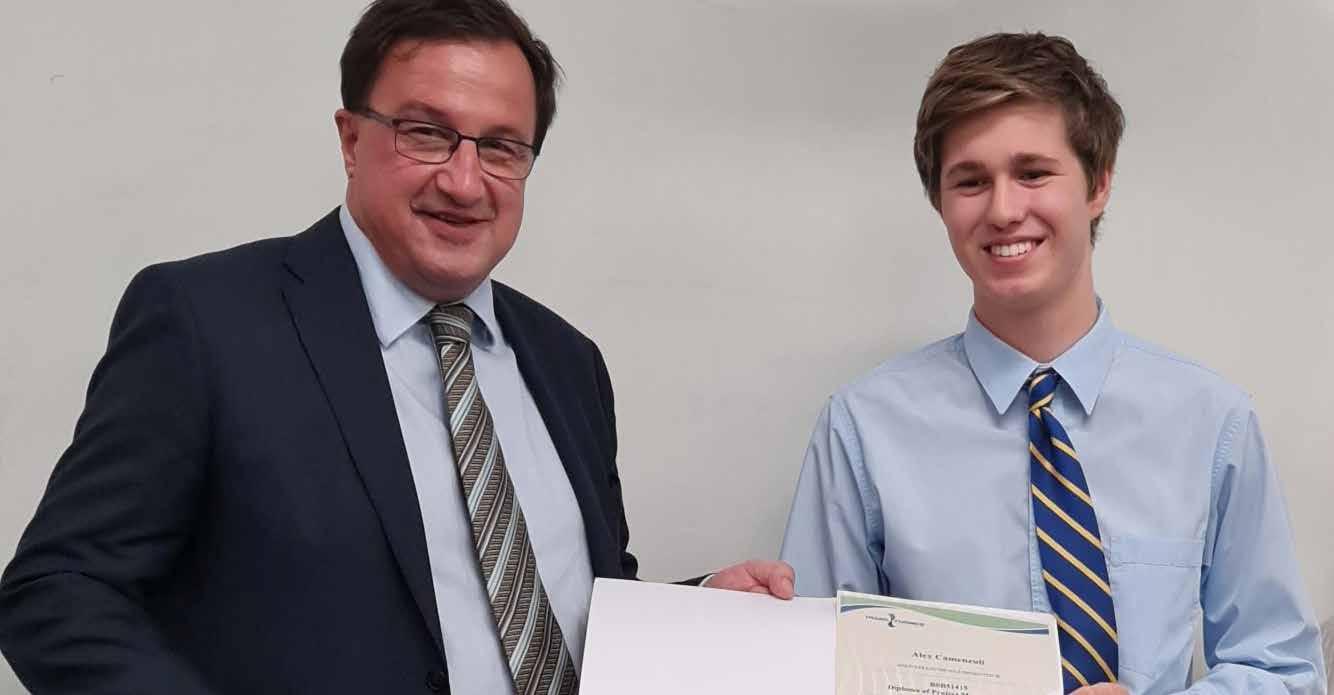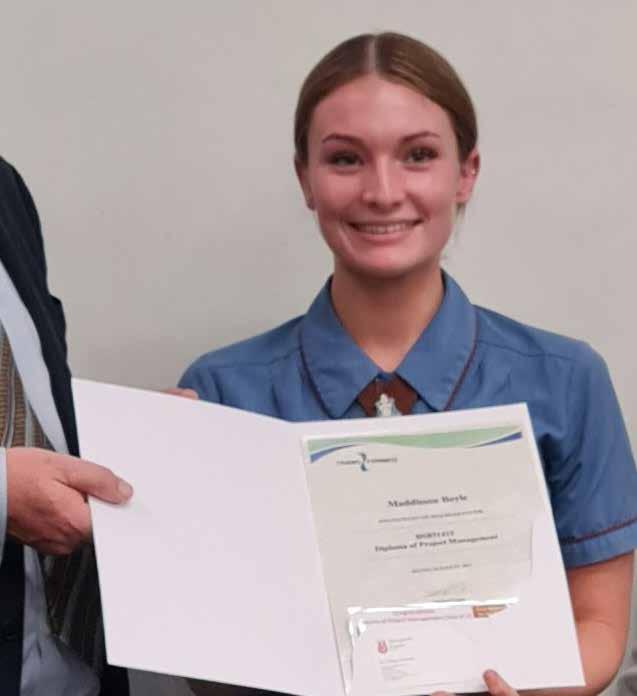
9 minute read
PROJECT MANAGEMENT AS A LEARNING TOOL
PROJECT IN THE SPOTLIGHT
REALISING THAT PROJECT MANAGEMENT SKILLS COULD FILL THE MISSING GAPS AND ENABLE SUCCESS FOR SENIOR SCHOOL STUDENTS IN NEED OF EXTRA SUPPORT, ELAINE ROBERTS AND HER TEAM BEGAN TEACHING THE DIPLOMA OF PROJECT MANAGEMENT TO THEM. FIND OUT THE IMPACT IT HAS HAD AND HOW IT WAS ACHIEVED.
Over the past 13 years, 300 senior school students, in need of extra support have gained a Diploma of Project Management, benefiting in a number of ways from Elaine’s program. What started as a great idea, has enabled the students to organise themselves better and increase their confidence, which has opened the opportunity for them to transition to meaningful work or entry to university. The Diploma of Project Management has become a learning tool as well as a qualification.
Elaine had a background in working with students with learning issues, and when she took part in Griffith University’s Australian National Research Council, she was able to observe the excellent work yourtown was doing, but realised too many school students were falling through the cracks, and something had to be done.

Maddisson from All Hallows’ School Brisbane accepting her Diploma of Project Management certificate (source: Elaine Roberts)
Then, through a family friend, Elaine came across a year 12 student injured in rugby, and after major surgery his dreams of architecture were in tatters, with gaps in his school results.
She taught the student a Diploma of Project Management in the afternoons after school. That student is now a manager of a multi-story construction project, with a degree in Urban Construction and Development, and an eye watering salary package within a leading construction company.
From this one student, the teaching of the Diploma in Project Management then got the go ahead to be taught to year 10-12 students in need of extra support in other schools in Brisbane after school, with similar successes being achieved by many who are now engineers, lawyers, teachers, nurses, environmental scientists, and others. So how did they do it?
THE PROJECT PLAN/ASSESSMENT
Using the lifecycle approach of Morris and Simmonds – which was perfect to recreate the reality of project management – Elaine helped students create an integrated plan that encapsulated all the initiating activities and documents of the twelve units (see next page) and formed the Project Plan.
She then introduced changes, the processes and flow-ons which became the updated Project Plan. Then reporting on progress and any problems that could be coming, and risks that could be emerging or changing became the Status Report. The Closure Report tied up all units and related the lessons learned and these became the topic of their presentation for a guest speaker of note, and then their parents, while a workbook ensured that all knowledge could be accounted for. This diagram shows the interaction patterns to set up initial documentation.
Integration is the key
What makes project management different from other forms of management is the essential nature of integration of all the project functions and the interactive way the projects move and the iterative need for change.
The effects of a lack of integration can be felt in learning institutions and in workplaces. Often in workplaces where certain areas of specialist expertise are developed, these become something like a series of fiefdoms to be protected. Without adequate communication and effective collaboration, work suffers, and this is what the teaching was aiming to combat.
OVERCOMING HURDLES
Striving for more
The first hurdle to overcome was attitude.

Project Management Plan (source: Elaine Roberts)
At first, Elaine appeared unreasonable as she asked for complete and perfect project documents, but the students seemed to accept the analogy of an incomplete house plan, whereby it wouldn’t be complete without a kitchen or bathroom.
Teachers and parents
The team conducted detailed cross mapping to ensure that the internal and external environment effect and factors were considered, along with stakeholders. Using technical terms to describe the parents and their goals, teachers and their goals, as well as how the environment affected all players became an interesting exercise and took quite a bit of the teenage angst out of the discussions. Clarity of understanding of the scope and how the students reached that was another interesting journey, but no one was writing an assignment on a misunderstood topic.
Time management
Then came the formula for time estimation that linked their understanding of their school maths normal curve, enabling them to estimate time from longest, shortest, and most probable time, for planned tasks. The spreadsheet with the inbuilt formula led nicely to the work breakdown structure of their school subjects.
The budget, the sequencing and dependencies, and the Gantt chart brought together time, task and cost. Leads and lags ensured that workloads could be adequately spread. That enabled Elaine to introduce the need for staging learning so the front brain could recognise and the back brain could take its time to make the connections and provide solutions. She also looked at Stephen Covey’s quadrants and the percentage of time students spent in each and compared it with their other time planning. This enabled understanding of the need for the flight or fight reaction, as well as the value of forward planning, prevention, and networking.
Risk management
Elaine claimed that students learning to drive should know how to drive themselves, their thinking, and their emotions before they took charge of a vehicle. ‘Their strategies for themselves’ was a critical component, which led to the quality measures of their Academic Improvement Plan.
However, the most interesting part was the integration of risk, contingencies, and issues management, as well as risk prevention into their thinking. They were thinking, ‘boys will be boys’, and Elaine was thinking, ‘if only I can keep them alive and functional until the brain is fully developed at 25’.
Giving students a detailed framework to deal with the overlapping and multiple priorities of their lives is invaluable. One student announced in class, “You know, Elaine, this stuff really works for doing anything in life, but you probably already knew that.”
Money management
The standards of things procured to enable the project led the students to consider quality, as the idea of world standards and ‘fit for purpose’ were dealt with. ‘Time is money’ was reinforced when the prospect of rework for unsatisfactory work was considered. On one hand, when someone is manufacturing nuts and bolts, they need them to fit every time, but if buying a laptop, they needed to consider the use to which the computer would be put. Our simulated purchase required comparisons of three laptops and weightings for multiple criteria about future needs, as well as value for money. Construction standards and ISO were considered and applied where appropriate. Students had to make a judgment based on criteria and make the link into planning within the Academic Improvement Plan.
Having a work ethic
It became evident to the learners that quality systems and standards needed to be operated by quality people who had the work ethic and capabilities for what they were doing. This allowed discussion and practice on finding those people, developing expertise in interviewing/being interviewed, as well as mentoring their team to multi-skill within a Legal and Human Resource framework.
Storing information
Expertise in storage and retrieval ensured that all team members learnt where to find the information created during the processes explained earlier. Knowing ahead of time what they needed to know and do, improved performance. The need for version control and effective filing of information was then very clear and had to be practised.
Acceptance of others
Knowledge alone is not the key to success: it takes the application, issues to be resolved, and people working together for the competitive edge. Teams are not effective unless there is diversity of thought and, often, action. All students had an individual, professional personality profile done by Bellcastle so that they were all shown in a positive light.
Stakeholders come in all shapes, have varying persuasions and bring their own unique world view to a project situation. If the students were to appreciate it, they could use it to their advantage.
Managing change
Throughout, it was easy to demonstrate that change had to be managed, and COVID-19 ensured that Elaine did manage it and see the links to quality and risk. The flow-on effect of change is critical to managing life and work.
A LIFE-CHANGING SUCCESS
Overall, Elaine used the Diploma of Project Management to weave a tight integrated system from plan to implement, to finish and review, that maximised brain acuity. It has become a true learning tool.
A Brisbane Boys College parent commented that, “the course took pressure off our son (and his parents) and has contributed to significantly better results in his other school subjects. I believe the course content had taught him many valuable skills that he will have throughout his career.”
Another parent said, “Thanks to the Diploma of Project Management, my son has already improved his school results and it has allowed him entry to his first choice at university.” Classes are now being taught over a number of schools in NSW and Qld, with more to come, Elaine hopes, and she is currently trialling the latest version of the Diploma of Project Management.
Author: Dr Elaine Roberts FAIPM CPPD has had a long career in management and people development, from teaching year one to university students and beyond. Her experiences and qualifications are both at PhD level and VET level. She strives to make the workplace a learning place.










